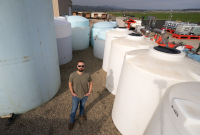Support strong Canadian climate journalism for 2025
The 4R principles promoted by Fertilizer Canada are increasingly accepted and practised by farmers across Canada. It makes sense to apply nutrients from the Right source, at the Right time, in the Right place and at the Right rate.
However, recent Fertilizer Canada lobbying has morphed the fourth principle from right rates to holding the line at rates without “a mandatory reduction in the use of fertilizers.”
The stewardship section on the Fertilizer Canada website has many commendable points about optimizing nutrient management, better crop and soil management, improving fertilizer efficiency, reducing energy use per harvested unit of farm production and improving net farm profit. Nevertheless, these assertions, and especially the last one, can be contradicted with their proviso, “without sacrificing yield potential.”
Highest yields may not be the most profitable yields depending on fertilizer and other input costs and weather conditions, which often constrain nutrient availability. Applying more fertilizer than can be used by a crop leads to inefficient nutrient management, leakage of nutrients from soil and wasted energy of fertilizer manufacturing, transportation and on-farm application.
It's not hard to imagine why Fertilizer Canada advocates for maintaining current or higher amounts of fertilizer on Canadian farms given the correlation of fertilizer amounts with sales revenue. Its stated rationale is that if the federal government enforces its 30 per cent fertilizer emissions reduction target by 2030, Canadian farmers will lose $48 billion. Daniel Schuurmann and Alfons Weersink in their brief and potent analysis — Is Fertilizer Canada Crying Wolf? — deftly refute the $48-billion claim.
Fertilizer Canada also warns that a reduced overall amount of fertilizer in Canada “risks Canada’s contribution to the global supply of food,” the putative slam-dunk argument for not sacrificing yield potential. Yields of what? For example, in our current food system, the European Union uses 3.3 million tonnes of wheat and 6.4 million tonnes of corn for biofuels. Sara Menker of Gro Intelligence calculates that global biofuel crops diverted from food could have provided 2,000 calories per day to 1.9 billion people.
Furthermore, Will Steffen and his colleagues demonstrated more than a decade ago that we have crossed the planetary boundary into the high-risk zone of excess reactive nitrogen and phosphorus in our biosphere, and correlated this with synthetic fertilizer applications. The 4R principles, especially right rates, might prevent excess leakage of nitrous oxide (a greenhouse gas 300 times more potent than carbon dioxide) into the air and nitrates into the water. However, insistence on 3R at the same or increased rates thwarts efforts to lower such pollution.
In our current moment of planetary history, we use prime farmland to grow more feed than needed and give food-grade grain to livestock. By optimizing food processing byproducts and forages for livestock, Ontario could reduce arable land for feed production by 40 per cent while maintaining sufficient animal protein in an adequate diet. Farmers could choose to grow food crops on that 40 per cent of land now used for feed.
I recommend farmers be incentivized to reduce fertilizer rates. Chemically synthesized nitrogen fertilizer is especially effective for increasing crop yields, but it also leaks as nitrous oxide and nitrate. Let’s suppose that on average, corn farmers apply 180 pounds of nitrogen fertilizer/acre for a yield of 180 bushels corn/acre — a ratio of 1.0 (180/180). This is a ratio of one part nitrogen fertilizer to one part of yield in bushels. For those who reduce the ratio to less than one, payments could be proportional to the reduction.
For example, by employing genuine 4R principles, a lower fertilizer rate of 150 pounds of nitrogen fertilizer/acre might result in a slightly lower yield of 170 bushels corn/acre, with a subsequent ratio of 0.88 (150/170). Others may use genuine 4R principles by applying manure to support corn growth and then limit nitrogen fertilizer to 90 lbs./acre. If the manure supplies enough nitrogen, the corn will yield 180 bushels/acre and the ratio will be 0.5 (90/180). Organic farmers, who do not apply synthetic fertilizer, would have a ratio of 0 (0/150). Organic systems can still achieve average yields of about 150 bushels corn/acre.
Similar incentive payments could be calibrated to average fertilizer-to-yield ratios for each crop, in each region. Payments should be contingent on the submission of a nutrient management plan to ensure manure or other organic amendments are not applied in excess.
Nitrogen fertilizer is an energy hog when manufactured and accounts for more than 50 per cent of total energy use in commercial agriculture. The fossil fuels, especially natural gas, to manufacture nitrogen fertilizer result in concomitant GHG emissions.
For Canadian agriculture to meet its 30 per cent fertilizer emissions reduction target by 2030, it is critical to reduce the overall amount of nitrogen fertilizer used in Canada and not default to 3R and the same to increased rates. This target is necessary and possible, so let’s get on with it.
Ralph C. Martin, PhD, professor (retired), University of Guelph. Information on book, Food Security: From Excess to Enough, at www.ralphmartin.ca






Comments
Same principle applies to both crop growth and economic growth. Maximum growth is insanely destructive, but that's the norm.
Thank you so much.
The political arguments about climate issues are so draining and eye-rolling. The technocratic discussions of how we could do better, and how affordable that would be, always leave me optimistic and upbeat. We can do this(!) We just have to decide to do this.
An excellent article.
However, I'd also like to see more on regenerative agriculture with a strong focus on building soils rather than an exclusive focus on eliminating artificial nutrient inputs. Cover crops and perennial cash crops can go a long, long way to preserving already depleted soils (one byproduct of chemical farming) and building them up again with organic matter and carbon and nutrient absorption from the atmosphere (a natural technique born to fight climate change!) and fixing them into the soil profile.
In that light, getting rid of ammonia-based fertilizers is merely a small first step.